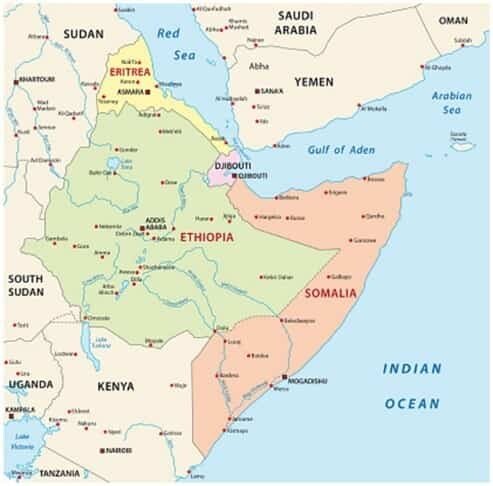By
Dr. Suleiman Walhad
April 24th, 2022
April 1st, 2022, was the first day that ATMIS (“ATMIS”) took over from the old AMISOM as was directed by the United Nations Security Council on March 31st, 2022, just hours before the effectiveness of the new Mission. Were they fooling us, as an April Fools Day prank? Indeed, this was not a prank at all, but who is ATMIS and who was AMISOM?
ATMIS is the African Union Transitional Mission in Somalia and AMISOM is the old African Union Mission in Somalia. Both are actually African soldiers sent to stabilize Somalia and bring it back from the political abyss it slipped into some thirty years ago – a long time. AMISOM was sent to Somalia some fifteen years ago to fight off terror groups and stabilize the country. Despite some initial successes in the early years of its presence in the country, the Mission proved to be a complete failure, where the soldiers from the poor source countries, were in Somalia, not to die fighting terror groups, but to earn a living. This was supported by the governments of the source countries, who saw this as new source of income for their administrations as the funds were paid for by members of the United Nations, including the European Union.
AMISOM was funded through multiple sources including the UN Trust Fund for AMISOM, the UN Trust Fund for Somali Transitional Security Institutions, African Union member states, the AU Peace Fund, and a variety of AU/AMISOM partners including the European Union. The non-AU sources were asked for support of AMISOM since the AU’s member states were not able to finance the AU’s peace operation missions.
From various reports on the matter, we know that from the beginning of the mission, troops from the contributing countries and they were initially only from Uganda and Burundi, were paid US$ 500 per month. This was increased to US$ 750 per soldier per month in January 2009, but since this was claimed to be below what is paid for other UN peacekeeping operations, this was again increased to some US$1,028 per soldier per month. It was then that other African countries saw an opportunity to make some money and then jumped into the wagon of contributing countries. One country and more specifically Kenya, was not even invited to join but jumped into the fray through an invading force. This had to be rectified later after a continuous appeal by the Kenya government to the funding parties.
How the governments of the troop-contributing countries share the bonanza with their soldiers is a different story, but certainly, the governments of those countries do not release all the funds to the troops and retain at different levels some of the funds to cover what they would refer to as administrative expenses, but Africa being Africa, definitely some of these funds would be going to the pockets of the military bosses and their bosses, not counting that the major part of the funds that would not be coming to the troop-contributing countries but to parties under the radar, who enable the funds to be authorized and/or released.
As we noted earlier the AMISOM mission was generally a failure. On the one hand, the soldiers sent from afar and from near were not ready to die in wars that did not truly concern them, but since they were earning maybe ten times their old salaries, they had to take some risks, but those risks were minimized by staying in the camps and only moving out for some routine patrols from time to time. On the other hand, some of the troops are in Somalia for political purposes as some of the countries have political goals to score against Somalia and even territorial ambitions against the country. Somalia despite its weak situation, had to go to the International Court of Justice to keep the Kenyans at bay only to retain parts of its sea waters from the Kenyans. But that is another story!
And now we have ATMIS and how is it going to be different from AMISOM? Not much, really! AMISOM was a milking cow for the troop contributing countries and others behind the scenes who are enabling it. ATMIS will continue to be the milking cow and would stay longer than is initially being told to the poor Somalis. Who kills his milking cow? ATMIS is just another name for AMISOM to continue the same process that was going on, over the past 15 years and the name change is just to remove the taints it had acquired, over the years.
The milking cow process starts through instigation and agitation of local populace, who unknowingly rise against their governments, which opens the gates of hell for any government that does not address the needs of its population, even though they may be difficult ones to swallow. But the gates of hell are opened when others come into one’s state and take it over from within through all kinds of forces – terror groups and those fighting the terror groups confusing the unsuspecting population. These multi-headed snakes can rip off a country without the people of the country knowing and Somalis learned some hard lessons. The fake Somali nationalism, the clan allegiance, which is truly the nature of the people and the similar situations in the other members of the Horn of Africa States can only be addressed through a collective approach to shut off all the gates of hell that are being opened in the region. We know Ethiopia has its own tribal issues, which is the source that is being exploited today through the various unsuspecting populations. And so, the same goes for Djibouti and Eritrea.
The Horn of Africa does not need ATMIS or AMISOM or soon maybe ATME or ADJIM or AMER or whatever. The Horn of Africa States is being sold as a region of instability and in this respect, they highlight the ongoing conflict in Ethiopia, the TPLF story, the Eritrean issues, the recent political turmoil in Djibouti and, of course, the ongoing Somali internal conflict as a kind of a contagion disease in the region.
The region is now the center of a major geopolitical competition, as well. The rivalry between the United States and other Western powers on one side and Russia and China on the other, The Arabian Gulf minus Qatar plus Egypt on one side and Turkey and Qatar on the other is now at an all time high. All parties are trying to gain footholds or strengthen their presence in the region. This is all ominous for the region and its member states. These competitors will definitely use the prevailing cracks within the region such as the delayed electoral process of Somalia, the Tigray conflict in Ethiopia, and the Djiboutian Eritrean territorial disputes, and so on.
Major international players, as we noted in some other articles before, would continue to confuse the Horn of Africa States and would include in their conclusions, issues in other regions such as the problems of Kenya, South Sudan, Uganda and even Sudan, in the Horn of Africa States portfolio. Hence there would come forth other problems and other readings that are not truly relevant to the actual Horn of Africa States. Like a Burundian peacekeeper in Somalia is reported to have said, “I don’t want to defeat Al-Shabaab. I would rather scatter them to prolong my mission,” the ATMIS would not change one iota of the AMISOM mission. The African soldiers would not destroy or defeat the Shabaab. Only Somali soldiers dedicated to save their country from both the Shabaab and the ATMIS, would be able to defeat the enemy from within and from without. It goes for every member of the Horn of Africa States and their collective working together would ensure that such enemies do not creep into the Horn of Africa society.
The fact that AMISOM has failed in its mission is, sometimes, justified as poor leadership. In fact, this is far from the truth, for the intention of the leadership of AMISOM, in the first place was to keep Somalis busy on their pseudo-clan politics and keep the milking cow alive and kicking. They never really wanted to defeat the Shabaab, nor did they want to exit the country. They were, indeed, clueless about Somali people and their hatred for all foreigners who overstay in their lands. We are hopeful that the ATMIS process would not take the same course. It would be a bumpy one and more difficult than the experiences of AMISOM, for this time, they would face the Somali soldier and not ragtag rats, fighting from holes.
The Somali Government, indeed, has been building its army over the past several years but the building process also needs an extended helping hand. The United Nations, the Africa Union and even the so-called Arab League to which Somalia nominally belongs would need to work on removing the sanctions on the country to allow it to build a viable Somali National Army, without which the disasters of ATMIS would continue. AMISOM had already overstayed and ATMIS is just another name for AMISOM. It is the same soldiers and the same personnel. They must learn, if they do not know, that overstaying is courting disaster. It is better to leave before the old victory of 2007 is completely forgotten through a violence that would involve Somali soldiers, this time.
*Dr. Walhad writes on the Horn of Africa economies and politics. He can be reached at suleimanwalhad@yahoo.com
















